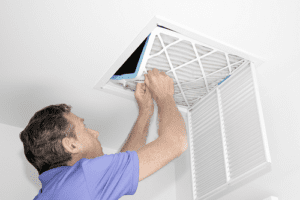One of the common parts of the swiftest-acting and most powerful commercial HVAC systems is a duct-based delivery system. While various kinds of radiant heat systems tend to be more efficient overall, they may lack the raw power necessary to heat large or heavily-trafficked spaces. Thus, retail businesses and restaurants often have an extensive commercial duct system that requires regular maintenance. The best way to properly care for your system is to understand how a commercial duct system functions, the parts that make it up, and then what kind of maintenance you should expect.
Duct Systems: Function and Components
 If you’ve had your HVAC system for several years, you may not even think about how it works — especially if your business regularly engages in preventive maintenance to keep the system clean and running effectively. However, the moment that you have a problem that impedes your HVAC system’s performance, you may become keenly aware of the different aspects that is part of its optimal operation.
If you’ve had your HVAC system for several years, you may not even think about how it works — especially if your business regularly engages in preventive maintenance to keep the system clean and running effectively. However, the moment that you have a problem that impedes your HVAC system’s performance, you may become keenly aware of the different aspects that is part of its optimal operation.
With a few outdated exceptions, the modern commercial duct system is a single-duct system that heats or cools air to a target temperature in a central location. Then, the system distributes the air to each zone with a separate thermostat. Before venting into the zone, the air passes through a reheating terminal that brings it to the desired temperature for this zone. Generally, different parts of your building will have different rates of heat loss to the exterior, so separate zones are essential to keep your building from having alternating rooms that are either too cool or too warm.
Thermodynamics explains that an equivalent amount of air leaves each zone as is pumped into it. Otherwise, the pressure would build up to an uncomfortable level in each zone, and your HVAC system would stop functioning. Therefore, each zone must have a register that brings air through the returning ducts. This air passes through to a return fan, which then pushes the air partly to a building exhaust and partly to the primary HVAC system. The latter part of the air mixes with fresh air from the outside to keep pressure in the entire building at a comfortable level. This newly-mixed air passes through a filter, then is heated or cooled to the appropriate temperature. From there, it is forced to the supply fan which pushes the air to each zone, completing the circuit.
The Materials of Your Commercial Duct System
HVAC contractors can use numerous kinds of materials when constructing your commercial duct system. One of the most common approaches to ductwork is the classic rectangular metal duct. Often, these ducts are constructed from an exterior of galvanized or stainless steel sheet metal. Inside, the ducts then have a layer of insulation, usually fiberglass wool. This insulation serves two purposes: prevent heat from transferring between the air and the duct and to provide acoustic insulation. Without this insulation, your system would be less efficient, and you could eavesdrop between different rooms by listening to sounds carried through the ducts.
As an alternative, your system may use fiberglass duct boards, which combine an aluminum exterior with the insulation itself. These boards are more flexible than sheet metal ductwork, so they may be a better choice for buildings that necessitate a large amount of twisting and turning. Finally, you may also consider plastic ducts. This style is less expensive, but also less durable than metal ductwork. Depending on your budget and building, however, they may be the best solution for your needs.
Necessary Maintenance for Your Commercial Duct System
The biggest aspect of ductwork maintenance is duct cleaning. We recommend that you clean your ducts every one or two years. There are many benefits to keeping clean ducts, both for system efficiency and overall air quality. If you neglect this essential step, then you may experience bacterial or mold growth, which can aggravate allergies and those with sensitive immune systems.
Otherwise, the most important maintenance is to ensure that your HVAC system itself is in properly-functioning condition. Although this need not be done as often as duct cleaning, it’s still a good idea to get your system looked at by a qualified HVAC contractor on a semi-regular basis. A simple inspection can save your business thousands of dollars by conducting preventive maintenance before a systemic failure.
How Your Commercial Duct System Affects Your Business
HVAC systems, by their very nature, are the kind of systems that you only fully appreciate when they aren’t working correctly. If they are functioning as intended, they provide a comfortable atmosphere that lets you focus on your work and the people around you. If they are failing, however, then everything grinds to a halt as the conversation turns to how hot or cold it is. Your commercial duct system is an essential part of your HVAC setup. If you want to keep your business focused on the work at hand, then speak with your HVAC contractor to ensure that your ductwork is appropriate for your needs. With a little maintenance every so often, you can have clean, comfortable air for years to come.

